
What we do here at Link Humans is helping our clients understand how they’re viewed by talent online, so they can improve their employer brand. Our approach is The Employer Brand Index and there are a host of use cases for this such as measurement, EVP development, and calculating ROI on employer branding.
During this pandemic, we decided to do research using the EBI methodology and understanding what really matters to talent during this time. Following the commentary we could see from candidates, employees, and alumni, we found that companies operating on the frontline of COVID-19 are undergoing drastic transformations. The aim here is to understand how frontline employees feel about their employment and what organizations are doing to respond to this crisis.
Our methodology, in this case, was to filter in any mentions of this virus or the impact it has caused by looking for keywords, context, and sentiment.
Stats:
- 1k+ pieces of employer brand commentary
- Covering the month of March 2020
- 15 of the largest US-based Fortune 500 companies
- A cross-section of industries on the frontline, including automotive, FMCG, financial services, retail, manufacturing, and logistics
From the second week of March, we observed a severe impact on the overall employer brand scores, as illustrated below for one of the largest retailers in the United States. In pre-COVID times, the score would have stayed roughly the same.
On the right-hand side, we can see some of the keywords picked out of commentary around the virus situation, color-coded like a traffic light with green being positive, red negative.
 What Matters to Talent Before & After COVID-19
What Matters to Talent Before & After COVID-19
Guided by the data, we tailored our original 16 Employer Brand Attributes approach and pinpointed the most important topics that COVID-19 has caused the most implications for talent on the front-line.
And here we can see the share of voice as percentages. The pink indicates how much of the commentary we’ve analyzed touches on this attribute; the white bars show how much this is normally discussed. For the normal, we used the corresponding period in 2019.
Some of these topics have doubled or even tripled in importance to talent. This doesn’t mean the other attributes are not essential, simply that these ones we’re looking at here are very topical right now in relation to COVID-19.
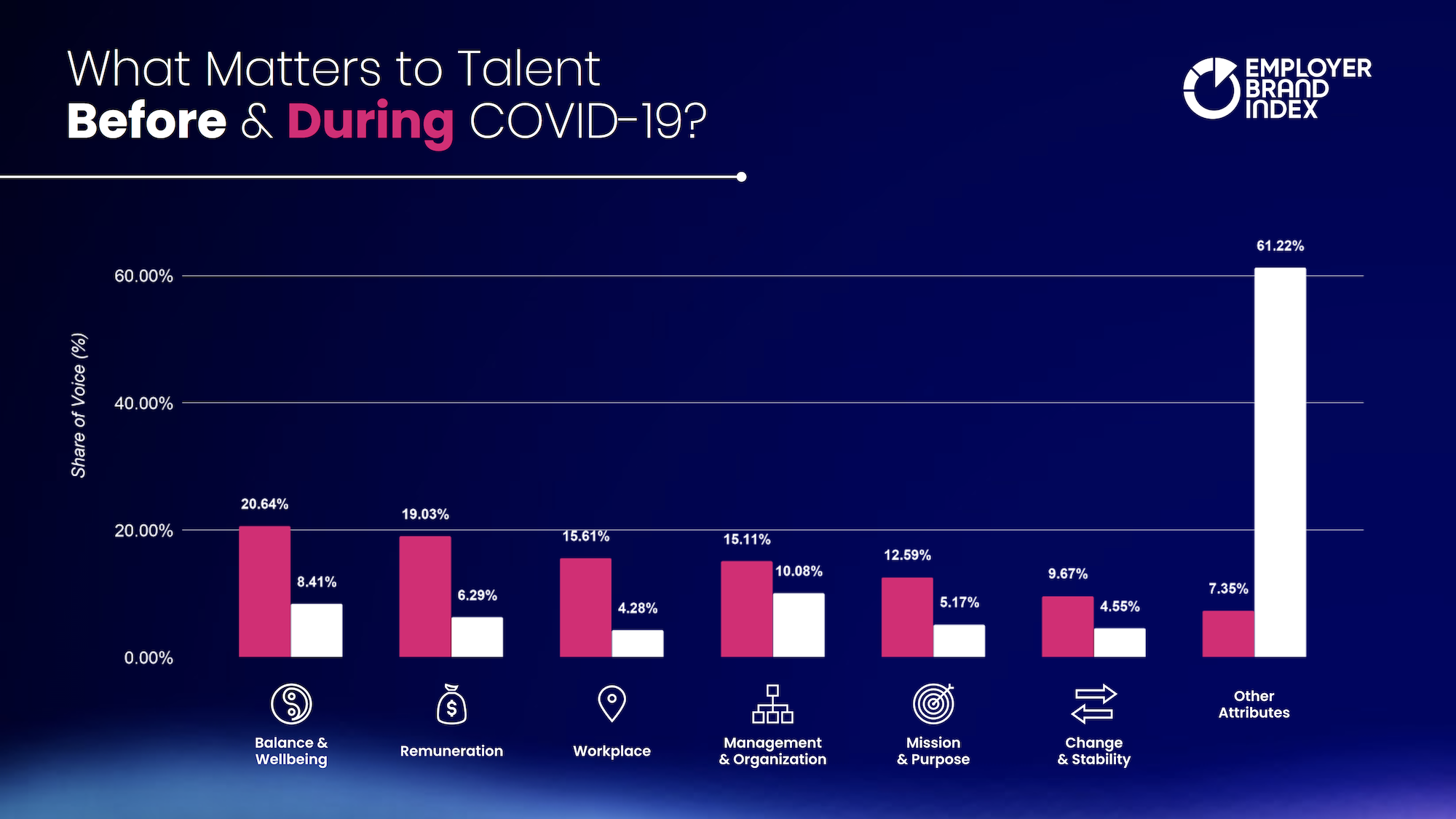
Let’s take a closer look at the six focus attributes, each with an example of an employer responding to the crisis that we identified through the data.
Balance & Wellbeing
This attribute covers everything from work/life balance to remote working to mental health. Balance & Wellbeing had the highest share of voice and a very low score. The pros were mainly around flexibility (PTO, work from home), and the cons were focused on health (fear going to work, lack of protective gear) and the Physical aspect of the job (hours, strain, pressure).
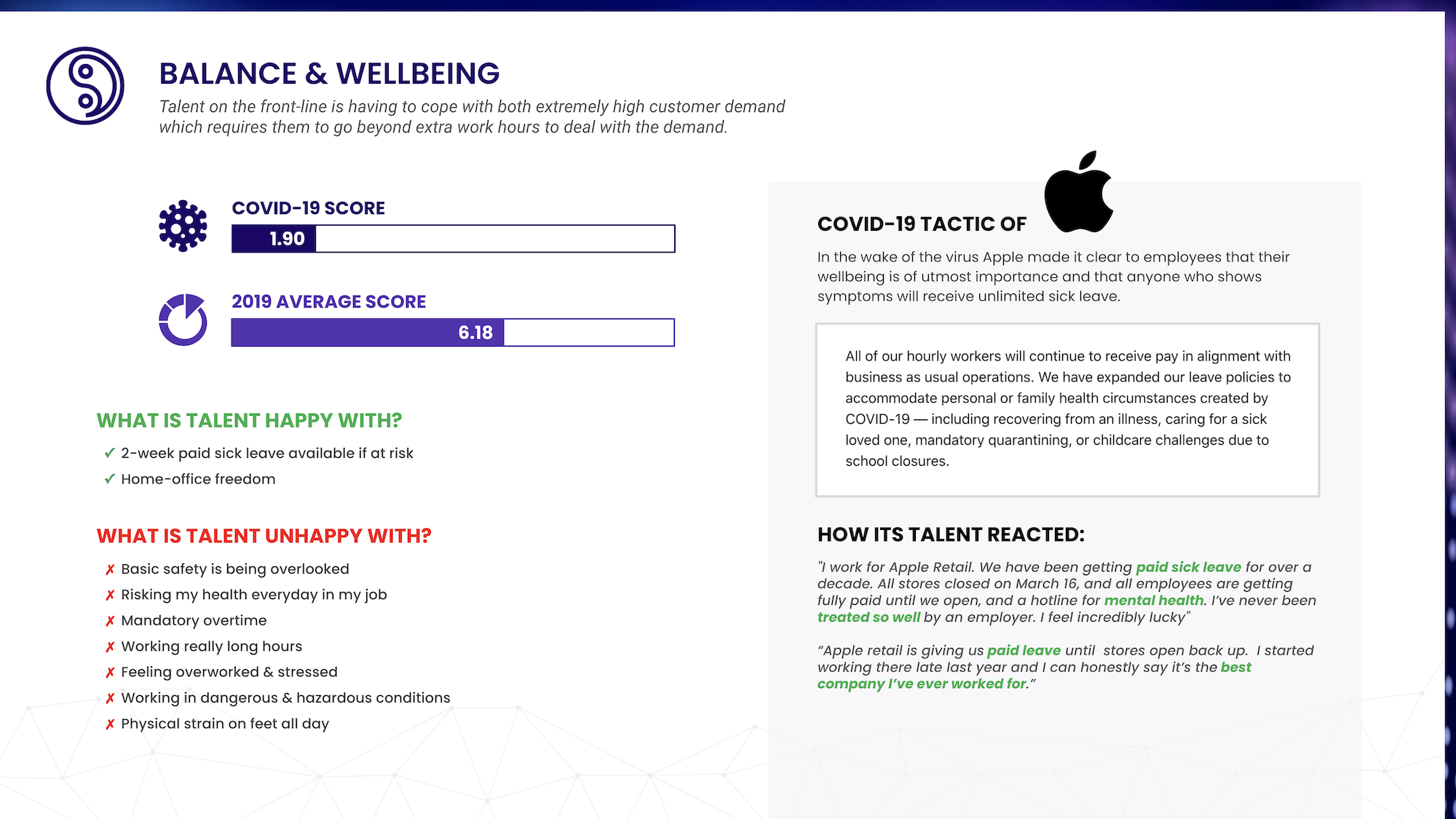
Very early on during this pandemic, Apple made the decision to give their employees unlimited paid sick leave, and that is sick leave for a variety of reasons. Also, they continue to pay everyone, even as they are not required to come into work.
The takeaways for Balance & Wellbeing is to be understanding and caring, people will have physical and mental health issues, and by offering generous paid for sick leave as well as therapy, coaching, and other support, we can genuinely help our employees and their families.
Remuneration
Remuneration is all about the financial compensation employees get for their work. This attribute had a low score and the few pros touched on bonuses (people were very shocked/surprised to receive this) and the cons concerned basic pay (paid minimum for work, less than leaders, part-time vs full-time pay).
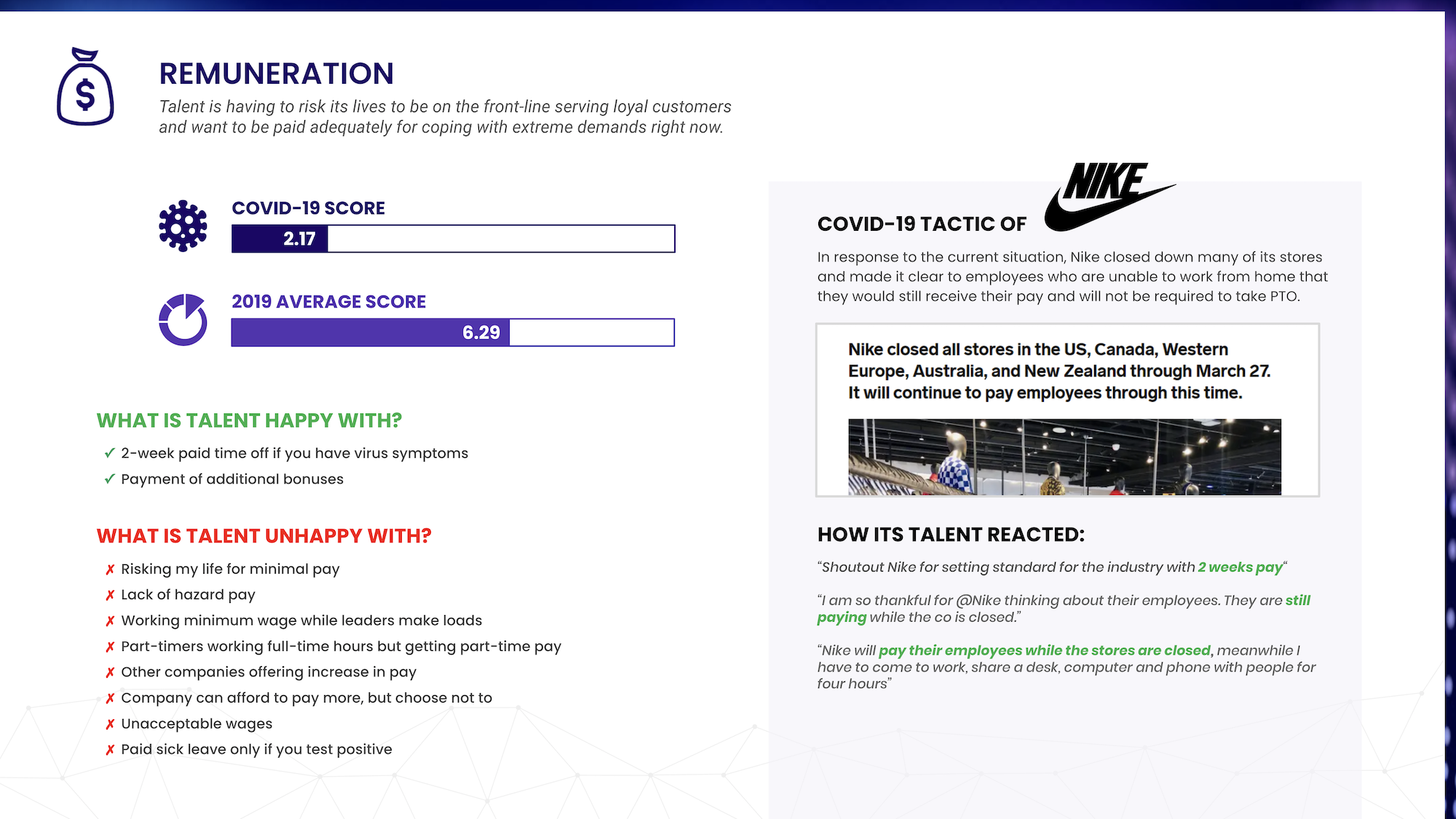
If you work in a store and the store closes, what happens? Nike closed a lot of their stores, and any employee that can’t work from home will still receive their pay until they can open up again. Nobody has to take PTO.
In terms of takeaways for Remuneration, the decisions on pay will sit with the C-suite, so that’s hard to change. Regarding the narrative, we find that more often than not, this is about how people feel about their compensation, rather than the actual dollars and cents in their pockets. With a clear narrative, explaining how the company remunerates its people, we can overcome some of these issues.
Workplace
This attribute is all about the physical environment workers perform their jobs in. It scored the lowest out of all attributes and the few pros we spotted were regarding safety precautions. The cons included sentiment about precautions not gone far enough (basic safety overlooked, not enough safety measures (gloves, etc) – leading to fear in coming to work).
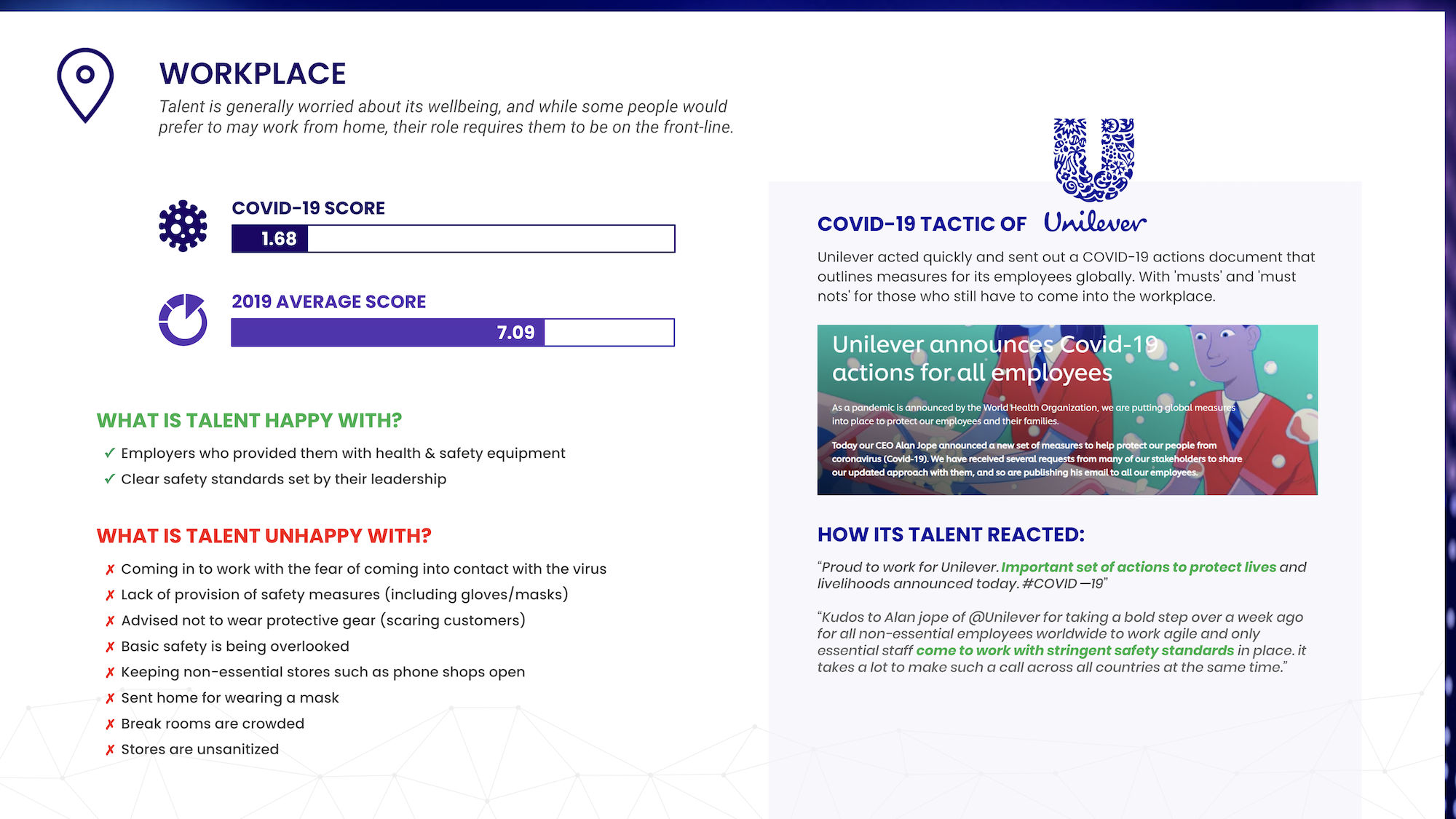
The physical workplace is especially critical to frontline employees who are in plants and facilities. Unilever acted very quickly and issued very clear guidelines around COVID-19, about ‘must’ and ‘must not’ behaviors and encouraging working from home. Only essential workers come to work with stringent safety standards in place.
The takeaway for Workplace is to have clear guidelines and a commitment to safety, just like we saw Unilever being super clear about behaviors, safety, and sending non-essential workers home before lockdowns, it’s about having clear instructions and especially now that offices are potentially opening up in the next few weeks and months.
Management & Organization
This attribute is all about how employees feel about management and the structure of the company. The pros included leadership being commended (support through uncertain times), the cons were about the job (pressure from management, micromanaging, management doing minimum), communication (‘left in the dark’, interaction is lacking, conflicting messaging).

We find that this attribute is sometimes all about communication, or lack thereof. And that’s in normal times. All the way from the CEO, Doug McMillon, posting here on LinkedIn, we’ve seen strong leadership communications from Walmart. This has had a positive impact on employer brand.
The takeaway for Management & Organization is to offer transparency and support; employees want to see that the top leaders of the company care, keep them informed of what is happening and that they have their back. How can your leaders be transparent and show support?
Mission & Purpose
This attribute is about whether employees feel aligned with the ‘why’ of the organization, it scored the highest in this report and not far off from normal levels. The pros here included positive impact from the company (via core values, community support, prioritize customer), the cons were about profit motivation (so employees feel undervalued).

Ahold Delhaize USA stressed how important their people are to the business by offering various forms of social and economic support, which in turn instilled both pride and purpose. The company donated $10M to communities as relief, implemented safety measures, and ramped up hiring of new associates.
The takeaway of Mission & Purpose is how these align with fighting Covid-19. What is your company doing to help this fight, whether it’s feeding people, caring for patients, or keeping the economy going as best it can. Now more than ever, a clear purpose will influence employer brand.
Change & Stability
This attribute measures how talent feels about the rate of change and stability of an employer, this had the lowest share of voice out of the focus attributes. The pros included being grateful to still have a job (and start dates remaining), the cons were about feeling disposable and replaceable (people being fired, high turnover rates).
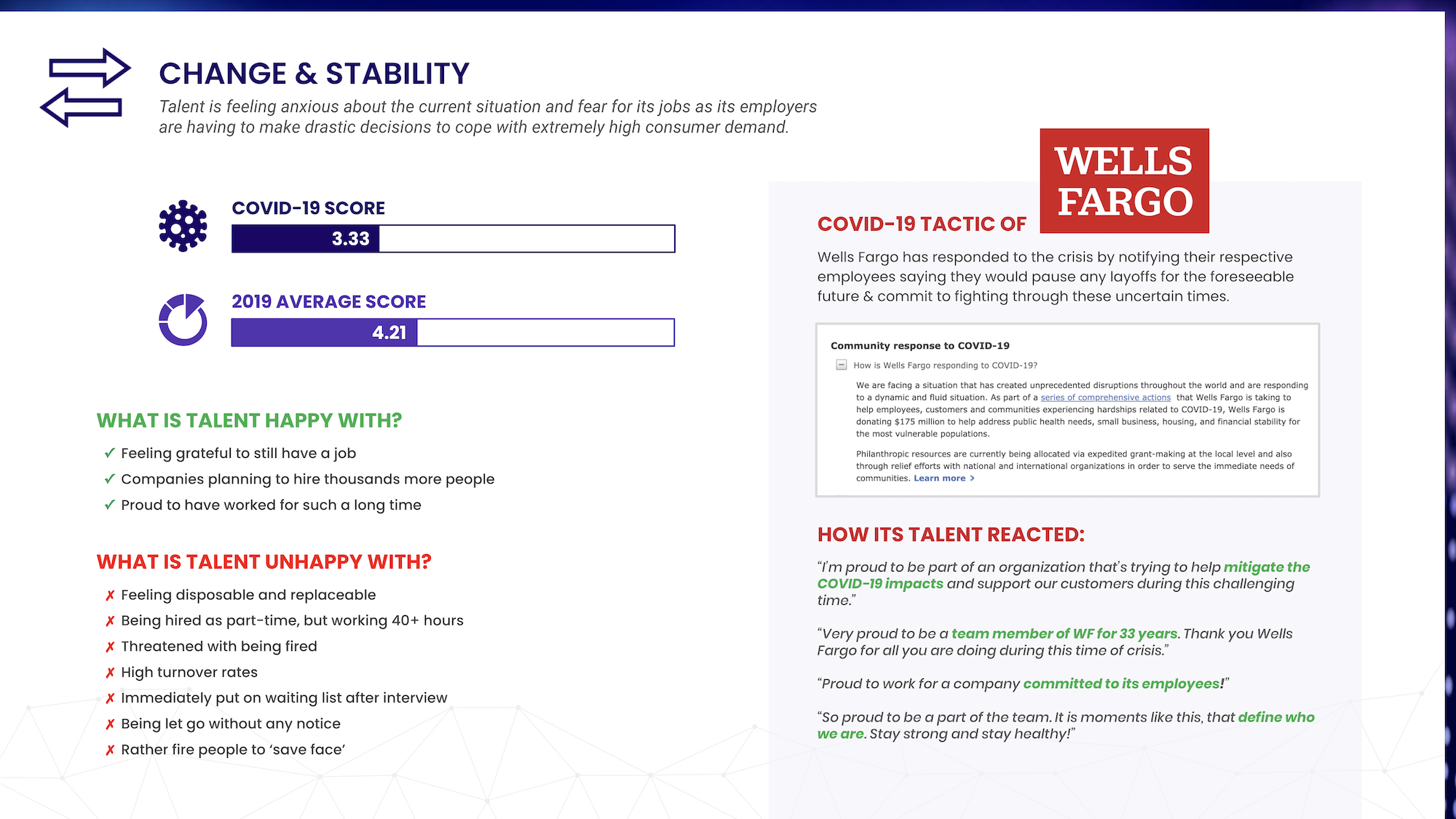
Wells-Fargo has paused layoffs for the foreseeable future, which will undoubtedly increase stability for its people. In addition to this, they’re donating $175M to help employees, customers, and communities facing hardship. So it’s not just employees, but also people with mortgages, overdrafts and the like. The bank is generally injecting stability in what is an ever-changing situation.
To me, Change & Stability is all about stretching out a helping hand, the world around us is changing, and what can we do to at least be stable in the minds of employees, candidates, and the community? Now is not the time to crack on with transformation programs or layoffs, rather see how we can help the people that depend on the organization.
Bottom line
Over the years of doing employer brand data research, we have seen fluctuations of themes and attributes from one month to another, but never on a scale like this. Will things return to pre-COVID levels once this situation is over? Nobody knows, but we’ll be sure to track it.
- Tagged With:
- Apple
- Nike
- Unilever
- Walmart
- Wells Fargo
STAY CONNECTED.
DATA-DRIVEN EMPLOYER
BRAND INSIGHTS.
Our newsletter is exclusively curated by our CEO, Jörgen Sundberg, for leaders who make decisions about talent. Subscribe for updates on The Employer Branding Podcast, new articles, eBooks, research and events we’re working on.



